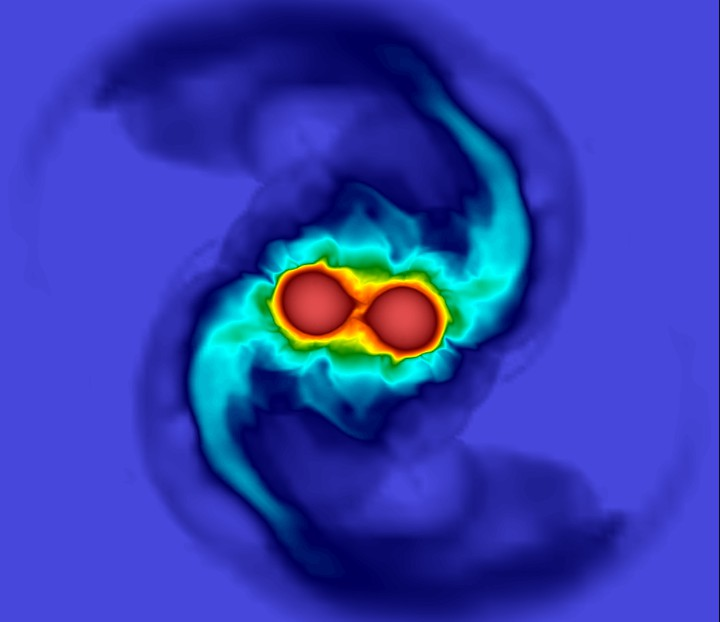May 22 2020
At the University of Birmingham, gravitational-wave researchers have designed a new model that could offer a new understanding of the structure and composition of neutron stars.
 The results from a numerical relativity simulation of two merging neutron stars similar to GW170817. Image Credit: University of Birmingham.
The results from a numerical relativity simulation of two merging neutron stars similar to GW170817. Image Credit: University of Birmingham.
The model demonstrates that it is possible to directly measure the vibrations, or oscillations, within the stars using the gravitational-wave signal alone. The reason is neutron stars tend to deform under the impact of tidal forces, making them oscillate at unique frequencies, and these encode exclusive information related to the star in the gravitational-wave signal.
This renders asteroseismology, which is the study of stellar oscillations, using gravitational waves from colliding neutron stars a potential new tool to explore the elusive nature of highly dense nuclear matter.
Neutron stars are the ultradense remnants of disintegrated massive stars. Although they have been seen in thousands in the electromagnetic spectrum, there exists very little knowledge about their nature. It is feasible to collect exclusive information by measuring the gravitational waves released when two neutron stars meet and form a binary system.
These ripples in spacetime were first predicted by Albert Einstein and detected first in 2015 by the Advanced Laser Interferometer Gravitational Wave Observatory (LIGO).
The use of gravitational wave signals to measure the neutron stars’ oscillations will enable researchers to achieve a new understanding of the interior of these stars. The research has been reported in the Nature Communications journal.
According to Dr Geraint Pratten, lead author of the study from the University of Birmingham’s Gravitational Wave Institute, “As the two stars spiral around each other, their shapes become distorted by the gravitational force exerted by their companion. This becomes more and more pronounced and leaves a unique imprint in the gravitational wave signal.”
The tidal forces acting on the neutron stars excite oscillations inside the star giving us insight into their internal structure. By measuring these oscillations from the gravitational-wave signal, we can extract information about the fundamental nature and composition of these mysterious objects that would otherwise be inaccessible.
Dr Geraint Pratten, Study Lead Author, Gravitational Wave Institute, University of Birmingham
Using the model created by the researchers, for the first time, the frequency of such oscillations can be directly determined from gravitational-wave measurements. The model was used by them on the first observed gravitational-wave signal received from a binary neutron star merger—GW170817.
Almost three years after the first gravitational-waves from a binary neutron star were observed, we are still finding new ways to extract more information about them from the signals. The more information we can gather by developing ever more sophisticated theoretical models, the closer we will get to revealing the true nature of neutron stars.
Dr Patricia Schmidt, Study Co-Lead Author, Gravitational Wave Institute, University of Birmingham
Next-generation gravitational wave observatories scheduled to be operational by 2030s will have the capability to detect far more binary neutron stars and observe them in considerably greater detail than what is feasible at present. The model developed by the Birmingham researchers will contribute to this science in a crucial way.
The information from this initial event was limited as there was quite a lot of background noise that made the signal difficult to isolate. With more sophisticated instruments we can measure the frequencies of these oscillations much more precisely and this should start to yield some really interesting insights.
Dr Geraint Pratten, Study Lead Author, Gravitational Wave Institute, University of Birmingham
Journal Reference:
Pratten, G., et al. (2020) Gravitational-wave asteroseismology with fundamental modes from compact binary inspirals. Nature Communications. doi.org/10.1038/s41467-020-15984-5.